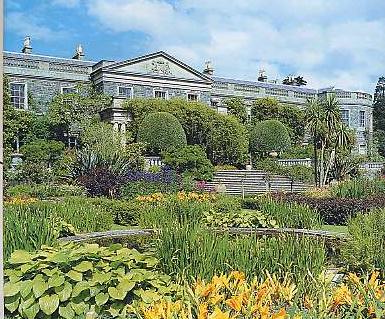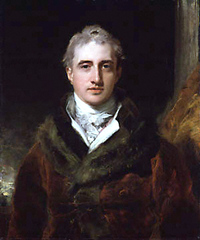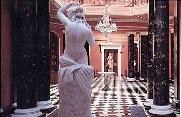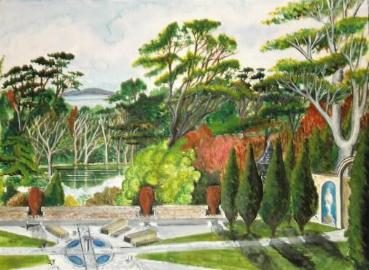| |
History
of the Mountstewart estate. |
||||||
The Savage family came to Ireland with de Courcy, they were installed on the Ards peninsular. They built a tower house at Portaferry some time in the 16th century, in later years they changed their name to Nugent. Some time after 1837 Major Andrew Nugent married the widow of Nicholas Ward owner of the Castleward estate which lay across Strangford narrows from the Nugent property, Nugent did much to improve the estate which had fallen into decline. Around 1569 queen Elizabeth I of English
granted much of the O'Neill lands in Ulster to Sir Thomas During the plantation of Ulster in the early years of the 17th century large parts of eastern County Down were granted to Sir Hugh Montgomery a Scottish planter. The Montgomery's developed the estate and nearby town of Newtownards until 1675 when financial pressure forced them to sell most of it to Captain Robert Colvill. The Colvill dynasty endured a similar length of time as their predecessors, the last Colvill, Robert was said to have been 'wild and indecent' in his conservation and 'disordered in his understanding' came under the influence of a mistress, Martha Launders, who persuaded him to sell the estate, the next owner was to be Alexander Stewart. Mount Stewart Estate Today. The Stewart family are descended from a Scottish settler Colonel W Stewart who in the plantation of Ulster was granted a small estate called Ballylawn near Moville in County Donegal. His younger son Alexander was born in 1700 after his education he was apprenticed to a Belfast linen merchant, eventually he established his own business and traveled widely on the continent. In 1731 his elder brother died and he inherited his fathers estate in Donegal. The family fortunes were enhanced considerably when Alexander married his first cousin Mary Cowan, from Londonderry daughter of Alderman John Cowan. Mary had inherited £100,000 from her brother Sir Robert Cowan who had been governor of Bombay. The trustees of Mrs Stewart's marriage settlement recommended that part of her inheritance which was in East India Company stock, should be sold and invested in property. The couple looked around and when Colvill put his estate Mount Pleasant up for sale in 1744 they bought it for the sum of £42,000, when purchasing the estate Alexander was offered the borough of Newtownards for £500, this would have in effect given him control of the administration of the town, against advice from his solicitor he foolishly rejected the offer, fifty six years were to pass before the Stewart's held complete sway in the town. The Stewart's took up residence in a house opposite the market cross in Newtownards town, and made plans for a house on the estate, this was designed by George Dance who designed among other things Newgate prison. Later additions in 1846 are by the Irish architect William Vitrusius Morrison. The most famous of the Stewart's
was Robert Viscount Castlereagh
he served as war minister and foreign Charles Stewart, younger brother of Robert became third Marques, he had acquired a well deserved reputation as a soldier in the Napoleonic War. In 1819 Charles had made a fortuitous marriage to Lady Frances Vane-Tempest, heiress to vast estates in north eastern England, this contained large deposits of coal, in addition she had inherited land in County Carlow from her mother. It is estimated the Londonderry's yearly income was in excess of £100,000, a figure in excess of that of some European royal houses. Charles' father had resided at Mountstewart and was attentive to his estate and, the new Marques chose to spend his time between Durham and London, paying occasional visits to Mountstewart. It could be said with some justification that Robert applied his military background and experience to estate management. Londonderry's behavior during the years of the famine did nothing for his popularity, in fact he was castigated in some Ulster papers, for his meanness regarding the provision of soup kitchens for the poor in Newtownards. In 1848 when the effects of the famine were manifesting themselves in the most grievous fashion across the land, extensive extensions and renovations were made to Mountstewart House costing £17,000 coming at a time when some 70 of his tenants were facing eviction, and many more were in the poorhouse, this may seem an extravagance, however in fairness the renovations probably gave much needed local employment. It is estimated that in County Down about 7% of the population died as a result of the famine, this figure may be a little less in the town of Newtownards and surrounding areas, which because of geographical and political reasons did not engage in agricultural mono culture. In the hallway are two classical nudes
carved in Rome in 1856, also a Carrara marble font is of the same The gardens at Mount Stewart are magnificent, they contain rare trees and shrubs from across the world, they were laid out from 1921 by Edith Lady Londonderry. In the grounds is a private cemetery where many of the Stewards are buried, it is romantically named Tir na nOg (land of youth). The house is open to the public during the summer months, the grounds all year. Part of the house can be hired for wedding services, receptions or other functions. The Temple of the Winds, situated in the grounds south of the house, with panoramic views over Strangford Lough, was built in the style of the temple of the Winds in Athens. It was used by the family as what could best be described as an up market picnic site, today it to can be hired as a wedding service venue. The pine floors of the temple are said to have been cut from bog pine found on the estate. The pinnacle of the Londonderry's social success came in 1903, when newly crowned king Edward VII and Queen Alexandra visited Mountstewart. In the political charged, atmosphere of the 1930 the Londonderry's were visited by Hitler's ambassador to Britain, Joachim von Ribbentrop. A letter exists from Adolph Hitler to Edith, Lady Londonderry, thanking her for her kind gift of the Ancient Musical Air's of Ireland, (possibly Buntings, Ancient Irish Airs, published in late 1790 after the Belfast Harp festival of 1792). Watch several video's of Mountstewart.
|
||||||
|
|



 seen many
owners throughout history, in Gaelic times it was part of the O'Neill
clan territory, this dynasty is said to have been founded by Nial
of the Nine Hostages in the fifth century AD.
seen many
owners throughout history, in Gaelic times it was part of the O'Neill
clan territory, this dynasty is said to have been founded by Nial
of the Nine Hostages in the fifth century AD. Smyth, Smyth
and his son also Thomas, were unable to hold the land, abandoning it mainly
because of harassment by O'Neill forces.
Smyth, Smyth
and his son also Thomas, were unable to hold the land, abandoning it mainly
because of harassment by O'Neill forces.  secretary during the Napoleonic war. The chairs used at the Congress of
Vienna are in the dining room of Mountstewart. Also in the house is much
of his paper work and correspondence with Nelson and Wellington. Upon
the death of the First Marques's in 1821 at the age of eighty two, Castlereagh
acceded to his fathers title, after only one year as Second Marques he
committed suicide by cutting his throat, some say this was because he
became unable to cope with the political pressure, others that he was
about to be exposed as a homosexual.
secretary during the Napoleonic war. The chairs used at the Congress of
Vienna are in the dining room of Mountstewart. Also in the house is much
of his paper work and correspondence with Nelson and Wellington. Upon
the death of the First Marques's in 1821 at the age of eighty two, Castlereagh
acceded to his fathers title, after only one year as Second Marques he
committed suicide by cutting his throat, some say this was because he
became unable to cope with the political pressure, others that he was
about to be exposed as a homosexual. period.
period.